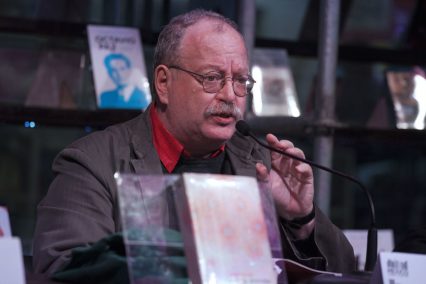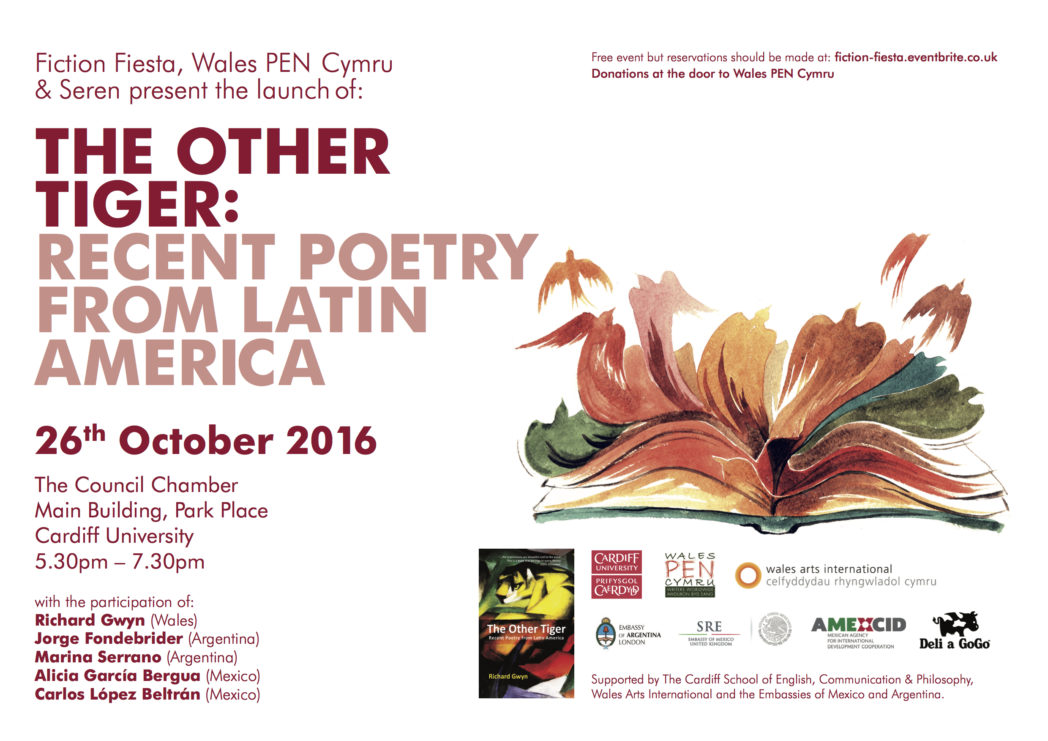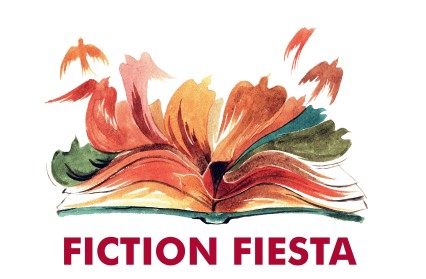Ahead of this year’s Fiction Fiesta, Richard Gwyn discusses the evolution of a new bilingual anthology of modern Latin American poetry, The Other Tiger.
It is 14th July, 2014: Bastille Day. I am in a house in Galloway, south west Scotland, having the only conversation I shall ever have with the poet and translator Alastair Reid. He tells me that barely a day goes by without him reading something by Borges. During our conversation he frequently speaks of Borges in the present tense, despite the Argentinian writer having died in 1986.
The first story I read by Borges, at the age of eighteen, was Tlön, Uqbar, Tertius Orbis. The first poem I remember reading by Neruda, a year or so later, was ‘To Don Asterio Alarcón, Clocksmith of Valparaíso’. Although the name would have meant nothing to me at the time, both translations were by Alastair Reid. Forty years on, when I finally get to meet the man, Alastair is a little frayed around the edges, but alert and bright-eyed as a moorland bird. He lives in New York City but spends part of every summer in the region of Scotland where he was born and spent his earliest years. I have been advised that he will prove an invaluable repository of experience and anecdote for my research into Latin American literature, since, apart from translating both Borges and Neruda, he knew them personally, and was on first name terms with most of the writers of the El boom: Gabriel García Márquez, Mario Vargas Llosa, Álvaro Mutis – but Borges was a special case, and Alastair speaks of him as of a respected friend.
Two things stand out in our conversation. The first is that, even as we talk of poetry, Alastair insists that for Borges everything was a fiction (though throughout our conversation he uses the Spanish word ficción). I know this already, because it appears in one of the essays in Outside In, a selection of Alastair’s prose writings: ‘Borges referred to all his writings as fictions… A fiction is any construct of language – a story, an explanation, a plan, a theory, a dogma – that gives a certain shape to reality.’ Including, Borges insisted, a poem.
And here we get to the tiger. It was a leap in the conversation that did it, the leap of a figurative tiger perhaps, and the next thing I know Alastair is reciting a section of the poem. ‘That’s such an amazing poem,’ he says, ‘the very last stanza is extraordinary… I know all this; yet something / drives me to this ancient, perverse adventure, / foolish and vague, yet still I keep on looking / throughout the evening for the other tiger, / the other tiger, the one not in this poem. He pauses, and adds: ‘That’s forever and ever and ever and ever. It’s a great corrective to poets, that one.’
Forever and ever and ever and ever. How strange that Alastair should choose these words to complete his memory of the poem. In Edwin Williamson’s biography of Borges we find this: ‘And yet something imposed on him “the senseless and ancient” adventure of searching for “this other tiger, the one that is not in the verse,” even though, as he would later observe to Antonio Carrizo, he knew that the quest was “infinite and vain” because “reality is unreachable through art.”’
Alastair starts telling me about one occasion in Buenos Aires when he and Borges were wandering around the Recoleta cemetery, and Borges wanted to show him something, but being blind, he couldn’t see the thing that he wanted Alastair to see; he wasn’t even sure that they were standing in the right place: ‘he was showing me something that he couldn’t see, and immediately there was something very bizarre about this and in all the encounters with Borges I began to realise that this notion of a fiction…’
He drifts into silence. Perhaps he is getting tired. We’ve been talking for three hours: he is eighty-eight years old, and is not well, as I later discover. What was he going to say? That Borges’ failure to see the thing that he was showing was, in its way, an invention, or re-invention of the thing being shown, a seeping through of memory into reality, and therefore a ‘fiction’ also? He could not see it, but he could at least remember, and so re-imagine it. And weeks later, reflecting on this ellipsis in the conversation, I find the following passage in Williamson’s biography, in which Borges is speaking of his blindness: ‘and there was I, in some way the centre of 900,000 volumes in various languages. I discovered I could hardly make out the title pages or the spines.’
And all I can think when I read that is Alastair’s description of Borges: ‘he was showing me something in Buenos Aires that he couldn’t see.’
I wasn’t sure where to start looking for the third tiger, the one that was not in Borges’ poem: and even though the quest might be ‘infinite and vain’ I decided to try and track it down. I thought perhaps I might glimpse its shadow in the poems gathered here.
*
The Other Tiger was conceived following a commission by the magazine Poetry Wales, back in 2010, to provide a two part ‘introduction’ to recent Latin American poetry. It was only once I’d embarked on the first few translations that I realised the hubris I had committed; how utterly unrealistic the task I had set myself, and how selective, or arbitrary, I was going to have to be. But the short essays were duly published over two issues, accompanied by my own translations of a fairly random assortment of poets. By dipping my toe into an ocean of possibilities, I became aware of how daunting the selection of an anthology from this vast territory would be. Nevertheless, I did not take much persuading when, the following year, it was suggested I embark on an anthology of Latin American Poetry for Poetry Wales’ publishers, Seren.
I should clarify, firstly, that the poets represented in this anthology write in the Spanish language, as I have not tackled the poetry of other languages of the Americas (notably Brazilian Portuguese, French, and the innumerable indigenous languages). I might have used the term ‘Spanish American’ but for the fact that many poets would feel that this tied them too closely to their colonial pasts, and besides, the term would also apply to North Americans for whom Spanish is a first language, whose writers (apart from those in Mexico) are not represented in this book either.
Secondly – and this was crucial to the design – I wanted an anthology of poems, rather than of poets, and did not want it laid out chronologically by author, or by country. What I wanted, first and foremost, was the freedom to select individual poems by a wide range of poets, and therefore decided that the book was going to be themed by topic rather than by nationality or date of birth.
Thirdly, since my intention was to focus on poetry of the late 20th and early 21st centuries, I decided to limit my selection to poets born after 1945; and the poets needed to be alive, as I was keen to discuss my translations with them wherever possible. Consequently, I wrote to all of the poets represented in the book, or else, in many cases, met them in person, and they have all received my translations and been invited to comment on or question them. Many of them have taken up this opportunity, raising interesting and sometimes perplexing choices for the translator – or else pointing out small but often crucial details of vocabulary or presentation.

The decision to confine the anthology to living poets meant the exclusion of some notable names, for example the Chileans Gonzalo Millán and Roberto Bolaño, and the Peruvian Jose Watanabe; but also the 1945 stipulation discounts poets from an earlier generation, some of whose poems I have translated previously – such as Nicanor Parra (born 1914), Claribel Alegría (1924), and Ernesto Cardenal (1925), to name only three – who also published poetry during the latter years of the 20th Century (and into the 21st) and are alive at the time of writing. This is unfortunate, but any anthology has to abide by certain criteria for consideration, and these, after much deliberation, were mine. As it stands, the oldest poet in the anthology was born in 1946, and the youngest in 1982.
The desire to make this collection as contemporary as possible was, to a significant degree, a reaction against the tendency of the available bilingual anthologies of Latin American poetry to take an historical perspective. The three major collections, published over the past 20 years by the University of Texas (1996), Oxford University Press (2009), and Farrar, Strauss & Giroux (2011) – are heavily historical in content, with only the last of these offering anything more than a thin smattering of poets born after 1945. Charles Simic and Mark Strand’s excellent anthology, Another Republic, provided a precedent of sorts, but that was published in 1976 and dealt with an earlier generation of poets.
I wanted to make available poetry that spoke to contemporary readers – those whose lives coincided or overlapped in time with those of the poets selected. This has not been done before in the UK nor, to the best of my knowledge, in the USA or anywhere else in the English-speaking world.
*
My first encounter with many of these poems was through listening to them, while attending readings at poetry festivals and book fairs across Latin America. If I liked a particular poem, I tracked down the poet responsible – either then, in person, or else later, by email. This is perhaps the smallest, but by no means insignificant group represented in the anthology, and accounts for the inclusion, to name names, of: Jaramillo, Fondebrider, Galán, Báez, Roca, Cote, Fabre, Freudenthal, Chirif, González Restrepo, López Mills and Samoilovich.
Next, I was steered towards other names through conversations with the many Latin American poets I spoke with over the course of five years, names I then sought out in bookshops and libraries and online.
Finally – the most extensive and time-consuming method by far – I searched independently, both on the internet and using whatever print anthologies were available, country by country, often acquiring a far greater quantity of poets and poems than I needed, and even making draft translations of poems I was never going to include, but which I felt obliged to sample and try out, in order to ‘get the feel’ of an unknown poet’s writing.
Having made a selection, I would then edit and revise the poems into a further draft, and where I detected problems with my translations I consulted either with the poets themselves or, where the poet’s knowledge of English was insufficient, with one or other intermediary, preferably from the same country (or province of a country) as the poet, in case of any local or specialist language variations.
By whichever method I came into contact with a poem, I needed to be attracted to some special characteristic or energy, a particular use of language or imagery or rhythmic power, provoking the same kind of response that I might have towards a poem in my own language, with the proviso that at the same time I needed to be alert as to whether or not it was likely to work well in English, and what the possible pitfalls of translation might be – those problematic words or phrases that can cause the poem to fail in its new garb. It only takes one of these for the whole poetic edifice to fall apart.
Occasionally, and perversely, it is those very problems of translation that will sometimes appeal: the lines on which you feel certain to come unstuck. Conversely, the most transparently ‘translatable’ poems are not always the best choices. As Susan Bassnett has commented: ‘Translating poems that seem to be very straightforward and easily understandable in the source language all too often end up as banal in English. Translating the apparently simple is, in a different way, as tough as translating a very complex text, for the effect of simplicity is only achievable with considerable skill, and a translator needs comparable skills.’19 Those particular skills, as I discovered, are perhaps the most underestimated in the translator’s repertoire.
Nor did I necessarily select – in cases where the poet was particularly well-known in his or her own country – the most ‘famous’ or well-circulated poem or poems by that individual. I chose poems because they interested me, and because they helped provide a broader overview of what is being written across the Hispanic American world.
*
If there is a bias towards poems from Argentina, Chile, Mexico and Colombia, it is because these are the countries to which my travels have taken me; travels which coincided with my reading of those countries’ poetries, and with incipient thoughts of translation, so that travel, my own writing, and translation have became thoroughly linked in my memory of those journeys. Over the period 2011-2015 I made four trips to Argentina, three to Chile, and two each to Mexico and Colombia. I also made two visits to Nicaragua. Sometimes these trips were only a matter of a week or ten days, to attend a poetry festival at which I had been invited to read my own work; other trips were more substantial, including a tour of Patagonia with three other poets from Wales during August-September 2013, and month-long stays in Mexico, Colombia and Chile during 2014 and 2015, while carrying out research for another project. It is, however, precisely these countries that have – with the possible inclusion of Peru – the strongest literary tradition of the region and the infrastructure to support it. I confess to having read more individual collections from these countries, and to having learned more of their literary culture. So, while my selection leans heavily in the direction of certain territories – both geographic and poetic – there is a reason for it, even a method.
But the preponderance of poems from certain national states did not prevent me from reading anthologies and individual collections from the other countries of Spanish-speaking America. Apart from the fine national anthologies of poetry published by the Chilean publishers LOM – and many others besides – there were several general collections that were especially useful. I might single out two: Sergio Ramírez’ Puertas Abiertas (2011), which provided a much-needed and extensive summary of Central American poetry over the period, and Gustavo Guerreo’s Cuerpo Plural (2010), whose title not only invokes a sense of Latin American poetry as parts of the same pluralistic entity – the Bolivarian ideal, or Pan-Americanism, if you will – but also insinuates a variously gendered body: a body that resists definition within the traditional binary of male/female, offering a more fluidly gendered body (and world).
*
The reading of a poem is itself a kind of translation, an act of decipherment. In this sense we are all translators, because a translator is – as Borges himself pointed out – ‘a very close reader; there is not much difference between translating and reading.’
Nor, for that matter, is there much difference between reading and writing. Nor even between reading and travelling. Or writing and travelling, whose synergetic relationship I have remarked upon above. As Lydia Davis has it: ‘to translate is also to read, and to translate is to write, as to write is to translate and to read is to translate. So that we may say: To translate is to travel and to travel is to translate.’
This selection of poems from Latin America came about through just such a confluence of travel, reading, and writing. The translations that ensue are a part of the continuum.













